
Article
The Shifting Tides of Empires: Using GIS to Contextualize Population Change within the Landscape of Seventeenth to Nineteenth-Century Mani, Greece [Post-print]
International Journal of Historical Archaeology
(2015)
Abstract
This study investigates the changing social landscape of the Mani Peninsula, Greece, from 1618 to 1829. Five primary sources of population data are combined in a GIS database, and spatial analyses are used to track patterns in population and settlement distribution. The results show that the preparations for war in Mani led to population loss, settlement fracturing, and a heightened potential for physical and visual connection. The processes of imperial conquest and resistance left a different imprint upon the Maniate landscape than in other parts of the Ottoman Empire, where settlements were occasionally relocated into more mountainous terrain for increased protection.
Keywords
- GIS,
- Spatial analysis,
- Population records,
- Ottoman Empire,
- Greece
Disciplines
Publication Date
March, 2015
DOI
10.1007/s10761-014-0281-2
Publisher Statement
Copyright © 2014, Springer Nature. The final publication is available at <https://link.springer.com/article/10.1007/s10761-014-0281-2>.
Citation Information
Seifried, Rebecca M. “The Shifting Tides of Empires: Using GIS to Contextualize Population Change within the Landscape of Seventeenth to Nineteenth-Century Mani, Greece.” International Journal of Historical Archaeology 19(1):46–75.
Creative Commons license

This work is licensed under a Creative Commons CC_BY-NC-SA International License.
